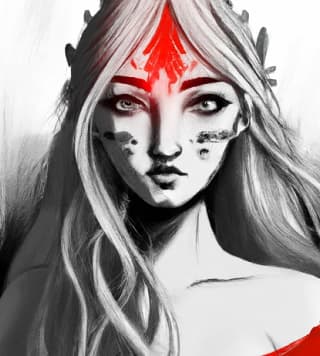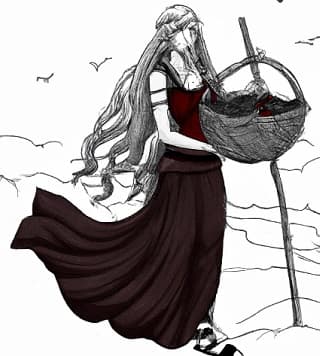Fulla: Norse Goddess of Fertility and Abundance

Fulla, depicted here as a beautiful and wise figure, was a goddess in Norse mythology known for her counsel and guidance.
Fulla (pronounced 'FOO-luh') is a lesser-known figure in Norse mythology, but she is mentioned in a few sources and appears to have played an important role in the beliefs and rituals of the ancient Norse people. In the Poetic Edda, a collection of Old Norse poems, Fulla is described as a servant of the goddess Frigg and is sometimes referred to as Frigg's "handmaiden." In this capacity, Fulla may have been responsible for helping Frigg with various household tasks and duties.
The spelling of Fulla's name can vary, but the most common and widely accepted spelling in modern English is "Fulla." This name may also be spelled with a single "l" as in "Fula," or with a "v" instead of an "l" as in "Fulva." These spellings are less common than the spelling with a double "l."
In the Poetic Edda, Fulla is referred to as "Bil" in the poem "Lokasenna." In this passage, Fulla is described as being a servant of Frigg and is referred to as "Bil." It is unclear what the significance of this name is or whether it is intended to be a separate figure or an alternate name for Fulla. Some translators and scholars have interpreted Bil as being another name for Fulla, while others have suggested that Bil may be a separate figure or a title or epithet used to refer to Fulla. The meaning and significance of the name Bil in this context is not definitively known, and further research would be needed to clarify its role in Norse mythology.
Fulla is usually depicted as a beautiful young woman with long, flowing hair and is often shown wearing a headband or crown, carrying a basket or sheaf of wheat. These symbols represent her association with abundance and fertility. Fulla is also sometimes depicted with a distaff, a tool used to spin wool, indicating her association with household tasks and domesticity.

Fulla, the Norse goddess of childbirth and fertility, is shown here carrying a basket, a symbol of her association with abundance and nourishment.
Fulla is described as being full of energy and is said to be able to "bear children as easily as a cow." In some accounts, she is also associated with fertility and is said to be able to grant children to those who pray to her. In addition to her association with childbirth and fertility, Fulla is also associated with domesticity and household tasks. She is sometimes depicted as carrying a distaff, which was a tool used to spin wool.
Fulla is known for her virtues such as loyalty, trustworthiness, and honesty, and is described as being a "goodly woman." In some accounts, she is so pure and chaste that she is able to keep the secrets of the gods and goddesses, making her a figure of great discretion and confidentiality. Fulla is sometimes invoked in spells and rituals related to fertility, childbirth, household tasks, and love and relationships.
Despite being a lesser-known figure in Norse mythology, Fulla played an important role in the beliefs and rituals of the ancient Norse people. She was likely revered as a goddess of fertility, domesticity, and virtue, and may have been invoked for help in various aspects of daily life.
Sources and References
- "The Poetic Edda" edited by Carolyne Larrington
- "The Prose Edda" by Snorri Sturluson
- "Norse Mythology" by Neil Gaiman
- "The Norse Myths" by Kevin Crossley-Holland
- "Norse Mythology: A Guide to the Gods, Heroes, Rituals, and Beliefs" by John Lindow
Please note that the information provided about Fulla and Norse mythology is complex and may be subject to interpretation and debate. The myths and stories of Norse mythology have evolved and been passed down through oral tradition and written accounts, and there may be variations in the way they are told and understood. This information should be used as a general reference and not as a definitive source on the subject.
If you notice an error on this web page, please email us at contact@historylists.org and let us know about it. Please be sure to include a brief description of the mistake you have noticed, along with the location of the mistake on the web page (e.g., the specific section or paragraph where it appears). We appreciate your help in keeping our website accurate and will use the information you provide to make necessary updates as soon as possible. Thank you for your assistance!
Other Norse Gods and Goddesses
- Baduhenna (Æsir) - Goddess of War and Revenge
- Baldur (Æsir) - God of light, beauty, and goodness, who was loved by all.
- Bil (Æsir) - Goddess associated with childbirth and fertility
- Billing (Æsir) - Father of the goddess Sif.
- Bölthorn (Jötunn) - A giant who was the father of the giantess Bestla, who was the mother of Odin, Vili, and Vé.
- Bragi (Æsir) - God of poetry, wisdom, and eloquence.
- Buri (Æsir) - The first god, who was born from the ice of Ginnungagap. He was the father of Bor, who married the giantess Bestla and became the father of Odin, Vili, and Vé.
- Beyla (Æsir) - Goddess of agriculture and bees.
- Borr (*Æsir) - The specific domain or sphere of influence associated with the god Börr in Norse mythology is not clear.
- Byggvir (Æsir) - Servant of Freyr, god of fertility, prosperity, and war, associated with agriculture and the harvest.
- Dellingr (Æsir) - God of dawn.
- Eir (Æsir) - Goddess of healing.
- Eostre (Æsir) - Goddess of spring and fertility, possibly also associated with the hare and the egg.
- Farbauti (Jötunn) - A giant who was the father of the god Loki.
- Forseti (Æsir) - God of justice and reconciliation.
- Freyr (Vanir) - God of fertility, prosperity, and peace.
- Frigg (Æsir) - Goddess of marriage and fertility, also known as the queen of the gods.
- Fulla (Æsir) - Goddess of abundance and fertility.
- Gefjon (Æsir) - Goddess of fertility and plowing.
- Gerðr (Jötunn) - A giantess who was the mother of the god Freyr.
- Gilling (Æsir) - A man who was drowned by the god Loki.
- Gjallarhorn (Æsir) - A magical horn that will sound at the end of the world, signaling the start of Ragnarök.
- Gjöll (Æsir) - A river that separates the land of the living from the land of the dead.
- Glaumvor (Æsir) - A giantess who was the mother of the god Heimdall.
- Gná (Æsir) - Goddess of the messenger of the gods.
- Gullinbursti (Æsir) - A magical boar that was a gift to the god Freyr from the dwarves.
- Gullveig (Æsir) - A goddess who was burned to death by the Æsir, but was reborn as the goddess Hecate.
- Heimdall (Æsir) - God of vigilance and guardian of the Bifröst, the rainbow bridge that connects the realm of the gods to the realm of mortals.
- Hel (Æsir) - Goddess of death and ruler of the realm of the dead.
- Hermod (Æsir) - God of speed and messenger of the gods.
- Hildisvini (Æsir) - A magical boar that was a gift to the goddess Freyja from the dwarves.
- Hlin (Æsir) - Goddess of consolation and protection.
- Höðr (Æsir) - God of winter and darkness
- Hönir (Æsir) - One of the three creators of the world, along with Odin and Loki.
- Honir (Æsir) - God of communication and diplomacy.
- Idun (Æsir) - Goddess of youth and keeper of the golden apples of immortality.
- Jörd (Æsir) - Goddess of earth and fertility.
- Kvasir (Æsir) - God of wisdom and knowledge, who was created from the spit of the Æsir and the Vanir.
- Lóðurr (Æsir) - Described as being involved in the creation of the first humans.
- Lofn (Æsir) - Goddess of forbidden love and marriage.
- Loki (Æsir) - God of mischief, deception, and fire.
- Magni (Æsir) - God of strength, who will survive Ragnarök and rule the new world.
- Modi (Æsir) - God of anger, who will survive Ragnarök and rule the new world.
- Mimir (Æsir) - God of wisdom and knowledge, who guarded the well of wisdom.
- Nanna (Æsir) - Goddess of love and fertility, who was the wife of Balder.
- Njörd (Vanir) - God of the sea, wind, and fertility.
- Odin (Æsir) - Chief god and ruler of the gods, who was associated with war, wisdom, poetry, and magic.
- Rán (Æsir) - Goddess of the sea and death by drowning.
- Saga (Æsir) - Goddess of history, poetry, and wisdom.
- Sif (Æsir) - Goddess of fertility and abundance, who was the wife of Thor.
- Sigyn (Æsir) - Goddess of fidelity and loyalty, who was the wife of Loki.
- Skaði (Æsir) - Goddess of hunting, skiing, and winter.
- Sól (Æsir) - Goddess of the sun.
- Surt (Jötunn) - A giant who will lead the forces of fire in Ragnarök.
- Thjazi (Jötunn) - A giant who was the father of the goddess Skaði.
- Thor (Æsir) - God of thunder, lightning, and protection, who was associated with strength and fertility.
- Týr (Æsir) - God of war and justice.
- Ullr (Æsir) - God of skiing, archery, and the hunt.
- Váli (Æsir) - God of revenge and justice, who was born to avenge the death of his brother Balder.
- Vár (Æsir) - Goddess of vows and agreements.
- Vé (Æsir) - One of the three creators of the world, along with Odin and Vili.
- Vili (Æsir) - One of the three creators of the world, along with Odin and Vé.
- Ymir (Jötunn) - The first giant, who was born from the melting ice of Ginnungagap.